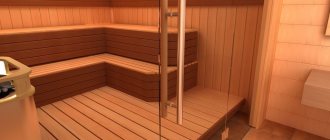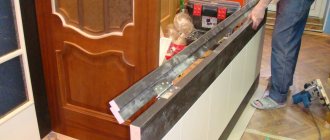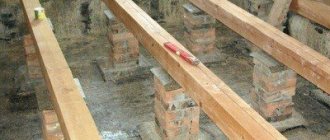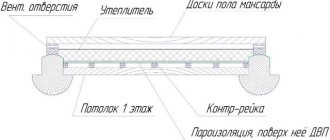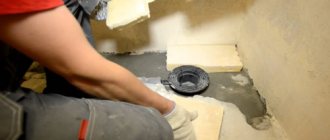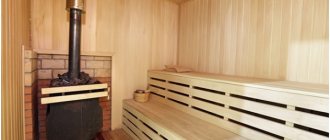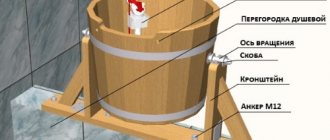The opening and door may be in different stages of readiness before starting work, so those who have something ready may skip unnecessary instructions.
General stages of installing doors in a bathhouse
The service life of doors largely depends on correct installation.
The entrance door is made of materials:
- tree;
- glass;
- metal.
The wooden panel is attached to the frame. Before installing the box, you need to cut grooves in the openings on the side and top. After installing the frame, install the threshold. The next step is attaching the fittings. After this, the canvas is fixed.
To install the glass sheet, you must first install the box in the opening, after which hinges or other mechanisms are installed. The final stage is hanging the glass and securing the handle.
Metal blocks are mounted in the same sequence as wooden ones. That is, first prepare the opening, after which the frame is installed. Next, the voids are filled with foam. The final stage is the canvas and accessories.
Preparing the doorway
Preparation will not take much time, since during the construction of the building all dimensions and geometric evenness have already been made.
But, if the installation is carried out in a log house, then you need to cut out the opening. At the same time, the connection between the logs weakens. A log building shrinks, so the opening must be made large for the block. The reserve is at least 10 cm.
For the strength of the logs, it is necessary to fasten them with a vertical wooden beam. This is done in 2 methods:
- Spikes are cut out at the end of the log, onto which a vertical beam is placed. Grooves of the appropriate size are cut into it.
- One common vertical recess is cut out in the opening, into which the timber is inserted.
If the opening is larger than the frame by more than 2 cm, then it is narrowed using a board. You should remember about the platbands, which cover 4 cm. If the level shows curvature vertically, horizontally, this is corrected.
Box assembly
The frame is assembled separately on a flat horizontal surface.
There are 2 options:
- Purchased block for installation in a bathhouse in the opening. In this case, the box is assembled according to the instruction manual. The parts are fully prepared for connection. Fastenings for this are included in the kit.
- If you create the frame yourself, its parts must be trimmed at 450. To do this, use a hacksaw and a meter to measure the length and width. The box is made 2 cm smaller than the opening.
Further actions are carried out with the door and the frame installed in the opening.
Installation of hinges
The hinges are installed as follows:
- stepping back 20 cm from the top beam of the frame, the first hinge will be placed;
- second (middle) - 30 cm down from the top loop;
- the lower loop is located 20 cm up from the threshold (if there is one).
If there is no threshold, then you need to measure from the floor, the installation of which has already been completed.
There are 3 types of installed hinges:
- External invoices are fixed with self-tapping screws according to the markings made in advance. Sometimes the question arises of how to attach an arrow hinge to a wooden bath door. It is fixed only at the top and bottom. It performs a decorative function. The arrow is capable of holding heavy oak sheets and not deforming.
- Screw-in - for glass panels. The frame has hinges already installed.
- Mortise - for them you will need to make recesses in the frame. This is so that there is no gap when closing the door.
The recess is made with a depth of 2.2-2.7 mm, depending on the thickness of the loop flag.
Installing a box in an opening: methods of attaching to a wall
Door frame installation methods:
- Using polyurethane foam. Place the box and secure it with wooden pegs. Using a level, you need to level the plane vertically and horizontally. After proper installation, the gap between the wall and the frame is filled with polyurethane foam. The foam expands as it dries. To prevent deformation, spacers are placed at 10 o'clock. After drying, the spacers are removed, the foam is cut off, and the pegs are knocked out. The box is held in place only thanks to the foam.
- Using staples, direct hangers. Suspensions for fixing elements of the metal frame of drywall are fixed with the middle part to the outside of the box with self-tapping screws. In this case, the ends go onto the wall from both sides. They are secured with dowel nails. If the ends stick out, cut them off. Before fixing the frame with hangers, it is installed on wooden wedges and measured with a level for evenness. The hangers are screwed to the box in advance. The remaining gaps are filled with foam and spacers are installed overnight.
- Using anchors. Through holes are drilled in the frame. Anchors are inserted into them and fixed in the wall. The anchors can be inserted in several places and then masked with a plug. Or you can insert them hidden under the hinges, the platinum for the lock. Before fixing the frame with anchor bolts, the frame is placed on wooden pegs and leveled. The gaps are filled with foam and spacers are installed. After drying, the pegs can be left or removed.
Installation of platbands
Platbands are placed last. Markings are made on the frame. The platbands themselves must be cut at the connecting places (corner parts) by 450. The cut is made in the following order: left, top, right part of the part.
The platbands are secured with headless nails or flat pins. During fixation, you need to check whether there is an obstacle to opening/closing the canvas.
Method No. 2. Circular casing made of timber
Installing doors in a log house using the second method can also be done with your own hands. The principle of its implementation is not much different from the first. All you need to do is install the blank under the box, following the rules mentioned above.
In other words, it is necessary to install bars around the entire perimeter of the opening. They can be fastened to each other in several ways:
- tongue and groove method;
- self-tapping screws;
- nails.
In addition, it is possible to install the casing without the use of fasteners. To do this, you need to fit the bars as tightly as possible to each other.
It should be noted that in most cases, the construction of log houses is carried out according to this principle. The pressure created by the weight of building materials is quite sufficient for the stability of the structure. The bars must be installed by surprise.
How to make and why you need a pigtail
The edge is made so that during the use of the bathhouse, as well as during shrinkage, there is no distortion of the doors.
When building a bathhouse from a log house, a gap of 10 cm remains between the lintel and the opening, and 6 cm on the sides.
To create a frame, you need to make holes for self-tapping screws. Two on the ceiling and on the threshold, 3 on the sides. Use timber. Holes are made in it for the same screws. The beam should be adjacent to the walls and ceiling. There should be a gap of 10 and, accordingly, 6 cm between the timber and the frame.
After fixing the timber to the walls, the remaining gaps are covered with tow. It will last at least three years. After this, it is removed and the places are filled with foam.
Material
By default, doors are made using 8mm tempered glass. It is similar to ordinary glass in appearance and has a similar manufacturing technology, with the exception of additional processing under high temperature conditions. The tempering procedure boils down to heating the glass to 500-600°C and sharply reducing the temperature, when the creation of compressive stresses inside the particles helps to increase its strength. What does heat treatment provide:
- Increased resistance to mechanical stress.
- High resistance to temperature fluctuations in the range -70°C-250°C.
- Health safety. If the integrity of the canvas is damaged, the risk of injury is minimal, since it is quite difficult to cut yourself on large fragments with no sharp edges.
The service life of doors largely depends on the quality of the supporting structure, which, in turn, is influenced by the material of manufacture.
Boxes are made from different types of wood:
- Spliced linden with low density, high strength, lightness and external softness. It smells very pleasant, does not contain resins, and has a beautiful light color.
- Aspens are the best solution for operation in conditions of intense steam generation and high temperatures. It has a high density, low content of resinous substances, provides a disinfecting effect and does not lose its beneficial properties over the years. The strength characteristics of aspen are almost similar to oak.
- Pines – pine boxes are found in products from Scandinavian manufacturers. It has a high resin content, which explains its immunity to wood diseases, is heat-resistant, strong and durable.
We install a door in a log bathhouse
The entrance to the bathhouse is a metal door or a heavy canvas of beams. But in the room itself they install an accordion door (locker room) or a compartment. Sometimes you can find an interior book.
Installation of the structure is carried out in the following sequence:
- They create a pigtail. It will serve as a guarantee of the service life of the door and will prevent the logs from loosening.
- Install the box in accordance with all the rules for proper installation. The use of a level and plumb lines is mandatory.
- After fixing the canopies, the canvas is mounted.
- Fastening platbands.
- The last step is fixing the handles.
The opening can be tied with timber using screws or “tenon-to-groove”.
Tips for choosing
When purchasing glass doors, in addition to the material from which the frame is made, you need to consider the quality:
- Profiles - in a good box, the thickness of the rectangular profile is 4-4.2 cm, and the depth is at least 7-7.2 cm. Narrow boxes and those with a shaped profile are less resistant to deformation during temperature fluctuations and high humidity conditions.
- Accessories (hinges). Despite assurances from door manufacturers that they use hinges produced by well-known European brands, including fittings labeled Fiskars or Abloy, their homeland is China. But this does not mean a lack of quality. You just need to understand that the quality of hinges from different Chinese manufacturers can vary greatly. The most reliable FL-75 hinges and their modifications: FL-75 Abloy/FL-75 Akma, which provide 180° opening of the leaf. FL-710 is an outdated version of the hinge from China, which is in stable demand due to its chrome-plated body. FL-715 is the cheapest hinge, often used in budget doors.
- Door handles. What is important here is the material of manufacture, the design of the handle and whether there are protruding parts on it that can cause injury. The best options are products made from beech, ash, oak; aspen and linden are acceptable; birch ones, which are in danger of quickly losing their appearance, are extremely undesirable. Compared to popular handles with a magnet located on a ledge, traditional models are safer because they do not have parts protruding from the blade.
Keep in mind that models with a pattern or frosted glass are not only beautiful, but also make visiting the steam room safer. There are many cases where bath lovers, “ignoring” the transparent sheet at the entrance, tried to go inside.
Installation of glass doors
Installing a glass door in a bathhouse with your own hands requires following the following rules:
- do not skimp on gaskets - cardboard, slats;
- Apply tape around the perimeter of the glass to avoid chipping;
- The glass sheet is installed by 2 people.
Glass is a fragile material, so the question arises of how to properly install a glass door in a steam room. This will require a little more time and effort. Care and consistency must be observed.
Proceed step by step:
- install the frame - before installation, remove the bar from it (on the back side);
- the frame must be fixed with wooden pegs and leveled;
- the box is secured with screws;
- hang the canvas, first using spacers;
- install the handle.
If the glass panel is without a frame:
- Before installation, remove all fittings from the canvas.
- You will need wooden supports that will create a gap from the floor of 10-20 cm. Spacers create a gap between the frame and the canvas of 10 mm.
- Carefully install the door and align the gaps.
- Places for hinges are marked on the frame and mounted.
- Glass is mounted in the hinges using gaskets.
- The last step is to install the handle and magnetic shutter.
Installation of glass doors is carried out step by step, carefully, with an assistant.
What tools will be needed for installation?
When deciding how to make a doorway and insert a door, first of all you need to decide on the tools necessary for this work. They must be at hand at all times. This will allow installation to be completed as quickly as possible. To carry out the work you will need:
- chainsaw or electric saw with a bar;
- hammer;
- perforator;
- circular saw or manual milling machine;
- chisel;
- construction measuring instruments: level (preferably laser), tape measure and square.
As a rule, searching for tools will not take much time, because all of them, one way or another, were used during the installation of the log house. Having prepared everything you need and understood how to install the door correctly, you can begin work.
Door hinge insertion
Precise cutting of door hinges
Precise insertion of door hinges begins with marking the door leaf. To do this, measure 20 cm from each edge of the door where the hinges will be installed.
Since we will cut the door hinges with an ordinary chisel, we should take into account some features of this method so that the hinges “sit” as accurately as possible. And since the doors that we often have to work with are laminated, accuracy when inserting is of considerable importance. This will be discussed below.
Installation of door hinges in photo examples
Naturally, the top of the hinge will coincide with the mark on top of the door leaf, and the bottom on the bottom. Moreover, when you measure 20 cm from the edges of the canvas, indicate with arrows which direction the loop will move, so as not to get confused.
Then we apply a loop along the edge of the mark and, with a sharpened pencil, outline it in fact; we will make an inset along the intended contour, because the loop map usually does not have strict geometry, and if inset in fact it will fit like a glove.
In order not to confuse the loops later, we make a mark on the back of each loop with a marker.
Since we will insert the hinges with a chisel and there is a risk of it moving during work, we need to make guides for it. To do this, use a wallpaper knife to carefully cut the loop outline mark.
Then we use a chisel to sample the cut area and get a recess step from which our chisel will no longer slip.
Next, we make a horizontal mark for the recess we need.
Then, using a chisel along the edge (place the chisel with its sharpened side towards the selected area) and a hammer, we go around the contour, going deeper into the thickness of the loop map and make a selection for fitting the loop.
Moreover, the hinge should not sit flush, but have a protrusion of half a millimeter (both on the door and the frame frame), this is done to allow for additional adjustment during the installation of the door.
Then we put our loop in the groove and use an awl to make a marking for the screws, and move it slightly to the side so that the screws press the card tightly to the edges.
We use a 3 mm drill to drill out a place for the screws so that the wood does not crack when screwing.
We put the hinges in the grooves and screw them on. The door is ready, it's time for the door frame.
We measure the hinges on the door leaf from top to bottom (sometimes they shift), write down the exact dimensions, add 3 mm each and make a mark on the frame frame.
The only difference is that all the marks are now from the top of the loop.
We repeat the entire process described above, your hinges will be embedded perfectly, all that remains is to assemble the frame and install the door.
Inset door hinges | Video explanation
Now installing door hinges manually will not be difficult for you.
Cutting and designing an opening in a log wall
- Before proceeding with this operation, it is necessary to temporarily secure even beams to the wall near the places where the opening was cut. This will prevent the wall logs from moving.
- Using a level or plumb line, draw the outlines of the opening in the wall. For our door they will be equal to the following values: width - 940 mm, height - 2090 mm. This takes into account the gaps between the door and casing frames (10 mm on both sides), and the fit of the casing posts into the tenon of the log wall. The lower level of the opening begins at half the diameter of the crown of the bathhouse frame, following the embedded crown.
- Using a chainsaw, we cut out the opening from top to bottom. Using an ax, we chop the upper and lower logs to the drawn horizontal lines.
- Next, using a chainsaw and a chisel, we cut out vertical spikes in the wall logs on each side of the opening with dimensions: width 60 mm, height 40 mm, symmetrically relative to the central axis. In the vertical posts of the casing, we select the appropriate longitudinal grooves and grooves for the upper spacer beams. We prepare a threshold with grooves for vertical tenons and quarters for planting vertical casing posts in them.
- We insert the threshold into the spikes, press it to the bottom plane of the opening and give it a horizontal position. Securely fasten with self-tapping screws.
- We place the vertical post at an angle at a quarter of the threshold and, using a hammer or an ax, drive it into the threshold and the tenons of the opening.
- We install the upper spacer bar into the grooves of the racks and hammer it into the grooves until it stops.
- We secure all connecting connections with self-tapping screws: in the corners, along the length, in the grooves, in the tenons, etc.
- So, the casing is ready, and the upper spacer beam has a gap between it and the cut opening. It is made specially and serves to compensate for the shrinkage of the bath. Now you can begin installing the door to enter the steam room.
Return to content
Useful tips
The very first piece of advice from experienced craftsmen is not to take on too complex projects or door designs. If you don’t have confidence in your abilities or lack experience, it is better to choose a simpler and more reliable door design option.
You cannot work with unprepared material. This applies to wood. Fresh pine can dry out and reduce the transverse size by 10%. This means that gaps up to 1 cm wide may appear in the door, which is unacceptable. It is necessary to properly dry and condition the boards.
During work, safety precautions should be observed. Power tools are dangerous, especially when working with wood. It is necessary to use personal protective equipment, glasses, and sleeves should not hang down. Gloves should not be used, especially when performing machine work (for example, when cutting wood on a circular saw). Hands can slip, which often leads to injury.
It is necessary to work with a sharp, well-threaded tool. High quality processing cannot be achieved using unprepared equipment. It is recommended to have sandpaper on hand so that you can sharpen the cutting edges at any time.
Main parameters for selection
It just seems that buying hinges for glass doors is not a problem. The selection of these parts in stores is truly huge, but it’s easy to get lost in this variety. It is necessary to take into account some features that affect the performance and attractiveness of the design.
First of all, it is worth highlighting the following characteristics:
- Sash weight. This is the main parameter that you need to know before purchasing awnings. Each of them is able to withstand a certain number of kilograms. The thicker, taller and wider the sash, the heavier it will be and the greater the number of hinges will have to be used. In addition to the glass itself, the weight of the door is affected by the frame, if provided, and the rest of the fittings.
- The angle at which the door opens. It’s good when the sash can be opened 90 degrees or more. In this case, not only will people be able to move freely, but furniture can also be carried through the opening. If necessary, install a special limiter so that when opening the canvas does not hit the wall or interior items.
- Door control. If the hinges are adjustable, then this is a good option. If necessary, you can independently correct their work and fix them in a certain position.
- Design. This is also a significant characteristic, because elements of a transparent design should not only work well, but also create a pleasant impression and harmoniously combine with the glass, taking into account its texture, shade, and patterns.
When choosing hinges, it is not superfluous to check their completeness for the presence of gaskets and fixings. They will help you install the fittings correctly.
As for the weight of the sash, if it is from 25 to 40 kg, then 2 or 3 canopies are enough. If the weight of the door leaf is at least 60 kg, then at least 4 hinges must be installed, and for a door weighing 80 kg or more, 4 fastening elements must be provided. In addition to the weight of the structure, the geometric size of the product and its length also matter. If the partition is interior and not too large, then fasteners up to 7.5 mm in size will be useful. In the case where the structure is heavier and weighty, then you need to choose canopies with a length of 10-12.5 mm. You cannot save too much on purchasing accessories.
Kinds
Wooden doors are classified depending on their design and location. Each variety has characteristics, strengths and weaknesses.
Massive
These are structures made of several boards fixed with glue. After joining, a solid shield is obtained, which is leveled with a thicknesser and covered with decorative compounds. Massive doors are the most expensive.
Advantages:
- high strength;
- environmental friendliness;
- good heat and sound insulation;
- attractive look.
Flaws:
- Heavy weight. The canvas must be secured with additional fasteners.
- High price.
The remaining disadvantages relate to the wood itself - low resistance to moisture, expansion and drying out when the temperature changes.
To protect wood you need to use special impregnations.
Paneled
These got their name from the paneled inserts. More often it is made of pine, which is sheathed with MDF, veneer, and varnished. Advantages:
- light weight;
- attractive appearance;
- durability, reliability;
- resistance to temperature changes;
- possibility of replacement and restoration of individual elements.
There are no serious shortcomings, but manufacturers often use low-quality raw materials to reduce the cost of the production process and do not comply with technology.
typesetting
This is a type of paneled canvas. They have the same advantages and disadvantages. Stacked structures are assembled from individual blocks of the same or different sizes, which are fixed with glue or tongue-and-groove joints.
Frame
The structure is a rectangular frame made of wooden boards, inside of which there is a cellular seal. The frame is sheathed with MDF sheets and other materials:
- Veneer - thin plates of natural wood. They have a natural woody structure. To make veneer last longer, it must be coated with impact-resistant varnish.
- Laminate is a coating consisting of thick paper, which is covered with a protective layer on top.
- Eco-veneer is a modern substitute for natural veneer. This is a film made from natural ingredients.
- PVC is a plastic covering of different colors.
Classification by location
Depending on the location, there are two types of paintings:
- Interior - simple canvases without locks.
- Entrance doors have a complex system of locks. Made from several layers of wood.
Entrance doors are heavy and require more fasteners to install them.
Cutting methods
To cut a doorway with your own hands, you will need a tool, but you can choose it correctly after determining the method of work being carried out. The method depends on the wall material. It is not advisable to chisel and sledgehammer, as the integrity of the entire partition will be compromised. You can carefully cut the opening using diamond, laser, waterjet or oxygen cutting.
Diamond cutting
For concrete partitions, the method of diamond cutting of a doorway using a grinder or circular saw is used. The cutting element of the tool is a metal disk coated with diamond.
The diamond cutting method has many advantages:
- low level of vibration eliminates the appearance of cracks even on loose partitions;
- during the cutting process, an accurate thin cut is entrusted along the marked contour and at the desired angle;
- the noise level of a working tool does not exceed the permissible threshold specified in sanitary standards;
- a small amount of debris due to the absence of chips, which is impossible to achieve when using a hammer drill.
Among the shortcomings
highlight the costs of purchasing expensive diamond blades. During work, the concrete wall is moistened with water, but fine dust still spreads into the room.
Laser cutting
Expensive equipment is used for laser cutting of openings. Previously, it was bulky and was used only in production. Modern laser cutting equipment is compact, but its high cost and specific purpose have made it popular only among specialized repair teams. The cutting of a concrete wall is made with a laser cutter due to the gas-discharge action.
Before starting work, the parameters of the wall
:
- thickness;
- the presence of a reinforcing frame;
- passage of communications inside the partition;
- grade of reinforced concrete wall.
Additionally, the floor of the apartment building where cutting is planned is taken into account, as well as the admissibility of wetting the concrete structure with water.
Waterjet cutting
Cold cutting of an opening in a wall refers to the waterjet method. A special installation is used for work. It creates a strong stream of water at a speed of 1 thousand m/s. The liquid in the tank is mixed with abrasive particles with a diameter of about 0.4 mm. The prepared mixture is fed through a nozzle onto the reinforced concrete structure and destroys it at the point of contact. The cutting force depends on the pressure. At the maximum power of the equipment, a reinforcing frame made of steel rods is cut along with the concrete.
The waterjet cutting method has the following advantages:
- precise cutting of concrete according to markings;
- the environment is not polluted due to the absence of chemical impurities and harmful gases;
- the concrete partition is not subject to mechanical and thermal stress;
- no wall vibration;
- low noise level;
- The method allows you to cut out a section of the partition at any angle, as well as make a doorway of complex shape.
Disadvantage
is the formation of dirt, the high cost of consumables, and the large dimensions of the equipment. Waterjet cutting is used on construction sites that have not been put into operation.
Oxygen cutting
The oxygen cutting method is also called spear drilling. To cut out a doorway, a machine with a metal tube is used. Oxygen is supplied through the spear under high pressure. At the same time, the jet is heated inside the tube to a temperature of 1400°C using a gas burner. After the spear has ignited, the external heating source is turned off. When the temperature reaches 2000°C, the tube is leaned against the concrete surface and turned slightly. During cutting, you cannot move the spear away from the concrete, as it cools quickly.
The disadvantage of this method is considered to be a fire hazard, as well as the possibility of getting burned. During cutting, hot slag particles scatter throughout the room.
Requirements
Doors to the bathhouse must meet certain standards:
- The height of the door block in the steam room of a Russian bath should be less than in apartments. The optimal height is 160 cm.
- The canvas should not deform when the level of humidity and temperature changes.
- The structures must be solid so that steam cannot pass through them.
- Door leaves should open outwards.
- The surfaces of the box and shield should not burn the skin when touched.
- Handles are best made of wood.
- Wood should not emit harmful substances when heated strongly.
Important! For greater safety of steam room visitors, a window should be made in the door.
Overhead hinges
No drilling or overhead. The most famous manufacturer producing glass doors is Leroy Merlin. This method is used only when the canvas is completely transparent and does not have a frame. Buying hinges for glass doors without drilling is required for systems installed inside apartments, shopping centers, and offices. Such canvases perform rather a decorative and delimiting function, so their canvases are light in weight and have a slight thickness. Canopies that are made in the shape of the letter P can easily withstand them.
A sheet of glass is inserted between two metal surfaces, after which it is fixed with clamps (pressure bolts). The adhesive gasket under such canopies is used for thin 5 mm glass, which is more often found in furniture doors. For thicker doors and interior partitions with a thickness of 8-10 mm, plastic or rubber gaskets are used. The weight of the canvas should not be more than 25 kg, then such loops will hold it. This hardware is much easier to install. Furniture hinges for glass doors without drilling are more noticeable on a transparent sash, so you need to choose neat and not too bulky models.
The main advantages of overhead fittings:
- the loops are installed opposite each other;
- they are suitable for interior doors and furniture;
- It is not necessary to fix such a canopy to the wall; it can also be fixed to the ceiling;
- You just need to clamp the glass sheet; installing such fittings yourself is not difficult.
There is a third mounting option - with partial drilling. In this case, no hole is made in the canvas, but only a small depression is made. This is a cross between the two methods. This approach provides a strong fixation, but it is acceptable for not too heavy sashes. This method is often used to install glass doors for furniture. Partial drilling does not violate the integrity of the glass sash and prevents its displacement, since the fastening elements fit exactly into the grooves made for them.
